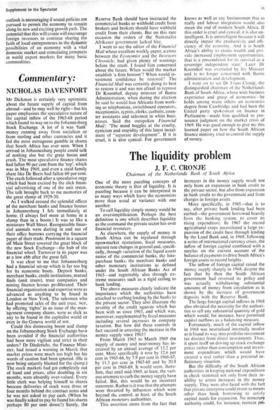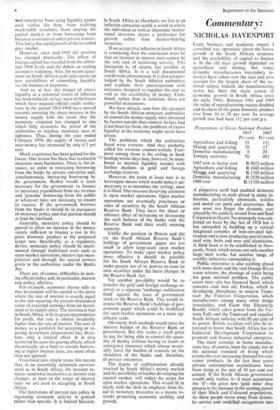The liquidity problem
J. F. C. CRONJE
Chairman of the Netherlands Bank of South Africa One of the most puzzling concepts of economic theory is that of liquidity. It is puzzling because it can be interpreted in so many ways which leave the economists more than usual at variance with one another.
To call liquidity simply money would be an oversimplification. Perhaps the best definition is one which describes liquidity as the command the private sector has over financial resources.
As elsewhere, the supply of money in South Africa can be regulated through operrmarket operations, fiscal measures, interest rate changes in general and, specifi- cally, through variation of the liquid assets ratios of the commercial banks, the hire- purchase banks, the merchant banks and other monetary institutions as defined under the South African Banks Act of 1965—and regrettably also through ex- treme measures such as a rigid ceiling to bank lending. The above measures clearly indicate the importance which the authorities have attached to curbing lending by the banks to the private sector. They also illustrate the severity of the credit squeeze which has been with us since 1965, and which was, moreover, supplemented by fiscal measures including several increases in company taxation. But how did these controls in fact succeed in arresting the increase in the money supply since 1965? From March 1965 to March 1969 the supply of money and near-money has in- creased by an annual average of 13.2 per cent. More specifically it rose by 12.6 per cent in 1965-66, by 7.9 per cent in 1966-67. by 1-1.3 per cent in 1967-68 and by 20.8 per cent in 1968-69. It would seem. there- fore. that until mid-1969, at least, the vari- ous attempts to curb the money supply have failed. But, this would be an incorrect statement. Rather is it true that the attempts were thwarted by influences which were beyond the control, at least, of the South African monetary authorities.
This assertion stems from the fact that increases in the money supply result not only from an expansion in bank credit to the private sector, but also from expansion in bank credit to the government and from changes in foreign assets.
More specifically, in 1965—that is to say, after private bank lending had been curbed—the government borrowed heavily from the banking system. to cover its rising expenditure. In 1967 the record agricultural crops necessitated a large ex- pansion of the credit base through lending by the Land Bank and, in 1968, following a series of international currency crises, the inflow of foreign capital combined with a surplus on the current account of the balance of payments to drive South Africa's foreign assets to record heights.
The inflow of foreign capital raised the money supply sharply in 1968, despite the fact that by then the South African government had reversed its policy and was actually withdrawing substantial amounts of money from circulation as is shown by the increase of government deposits with the Reserve Bank.
The large foreign capital inflows in 1968 also obviated the necessity for the authori- ties to sell any substantial quantity of gold which would, for instance, have permitted capital outflows as a balancing measure.
Fortunately, much of the capital inflow in 1968 was neutralised internally insofar as it found its way into portfolio investment (as distinct from direct investment). Thus, it spent itself on driving up stock exchange prices rather than consumption and invest- ment expenditure which would have created a real rather than a potential in- flationary situation.
But the difficulty of the South African authorities in keeping national expenditure in check stemmed not only from their in- ability to arrest increases in the money supply. They were also faced with the fact that private enterprise could resort to means other than bank borrowing to satisfy capital needs for expansion. No monetary authority could, for instance, restrain pn- 'ate enterprise from using liquidity gener- ated within the firm, from realising 'marketable securities, from tapping the • capital market or from borrowing from business associates or other private sources. This led to the rapid growth of the so-called grey market. However, since mid-1969 the position has changed drastically. The inflow of foreign capital has receded from the abnor- mal 1968 levels and the deficit on trading account is widening. Also, the recent agree- ment on South African gold sales opens up new possibilities of controlling liquidity via the balance of payments. And so, at last, the danger of excess liquidity as a potential source of inflation has been reduced; in fact. most of the forces which have negated official credit restric- tions in the period 1965-1968 have moved towards arresting the sharp increase in the money supply with the result that the monetary situation has changed to one which fully re-asserts the power of the authorities to regulate monetary ease or tightness. Thus, during the year ended February 1970. the supply of money and near-money has increased by only 6.3 per cent.
Much experience has been gained for the future. One lesson has been that restrictive measures must harmonise. There is, for in- stance, no point in restricting borrowing from the banks by private enterprise and, simultaneously, increasing borrowing by the government. Rather would it seem necessary for the government to finance its necessary expenditure from tax revenue and 'genuine' borrowing from the public at whatever rates are necessarx to ensure its success. If the government borrows from the banks it should be in pursuance of monetary policy and that portion should at least be sterilised.
Generally, monetary policy should be geared to allow an increase in the money supply sufficient to finance a rise in the gross domestic product at the projected target rate. Specifically, as a regulatory device, monetary policy should be imple- mented through traditional tools such as open-market operations, interest rate mani- pulation and through the special powers given to the authorities under the Banks Act.
There are, of course, difficulties in mak- ing official policy and, in particular, interest rate policy, effective.
For example, economic theory tells us that investment will be carried to the point where the rate of interest is exactly equal to the rate equating the present discounted value of expected earnings from an invest- ment to its supply price. The position is that in South Africa, with its great opportunities for profit, this rate is almost invariably higher than the rate of interest. The cost of money as a yardstick for accepting or re- jecting investment propositions has, there- fore, only a limited effect. It is also restricted because the gearing effects, which theoretically set a limit to outside borrow- ing at higher interest rates, are more often than not ignored.
Translated into simple terms this means that, in an essentially optimistic environ- ment as in South Africa, the investor re- mains somewhat insensitive to interest rate. changes, at least to the range of interest rates we are used to accepting in South Africa.
The limitations of interest rate policy in regulating economic activity is general rather than specific. It is limited because, in South Africa as elsewhere, we live in an inflation-conscious world, a world in which the individual as well as important institu- tional investors shows a preference for growth rather than interest-bearing securities.
If we accept that inflation in South Africa is continuing then the conclusion must be that an increase in interest rates cannot be the sole tool of restricting activity. This limitation is, of course, not peculiar to South Africa. It is a well documented world-wide phenomenon. It is also acknow- ledged by the South African authorities and explains their preoccupation with measures designed to regulate the cost as well as the availability of money. Com- bined, rather than in isolation, these are powerful instruments.
We have already seen how the attempts by the South African monetary authorities to control the money supply were thwarted by factors outside their control. In fact, had it not been for them, the problems of excess liquidity in the economy might never have arisen.
The problems which the authorities faced were extreme. And they probably called for extreme counter-actions. Fore- most among them is the ceiling to bank `;^k` lending whose days may, however, be num- bered as internal liquidity recedes with further declines in gold and foreign exchange reserves.
However, the point at issue now is to investigate means which would make it un- necessary to re-introduce the 'ceiling', once it is lifted. One measure deserving attention is open market operations. Open market operations are essentially purchases or sales of securities by the South African Reserve Bank. They have the direct or ultimate effect of increasing or decreasing the cash balance of the banks with the Reserve Bank and their credit creating capacity.
Unlike the position in Britain and the us the South African Reserve Bank's holdings of government paper are too small to allow large-scale open market operations. To make open market policy more effective it should be possible for the South African Reserve Bank to make greater use of its powers to issue its own securities under the latest changes in the Reserve Bank Act.
Yet another possibility would be to transfer the gold and foreign exchange re- serves to a separate 'exchange stablisation fund' against the issue of government stock to the Reserve Bank. This would in- crease the Reserve Bank's holdings of gov- ernment paper which could be mobilised for open market operations on a more sig- nificant scale.
Obviously both methods would raise the interest burden of the Reserve Bank or government. But this seems a small price to pay for being able to control the quan- tity of money without having to resort to emergency measures which almost invari- ably leave the burden of controls on the shoulders of the banks and, therefore, of private enterprise.
The degree of sophistication already reached by South Africa's money market and the possibility of further developing the capital market, will widen the scope for open market operations. This would fit in nicely with the shift in emphasis from fis- cal to monetary measures as a means to- wards promoting economic stability and growth.























































 Previous page
Previous page